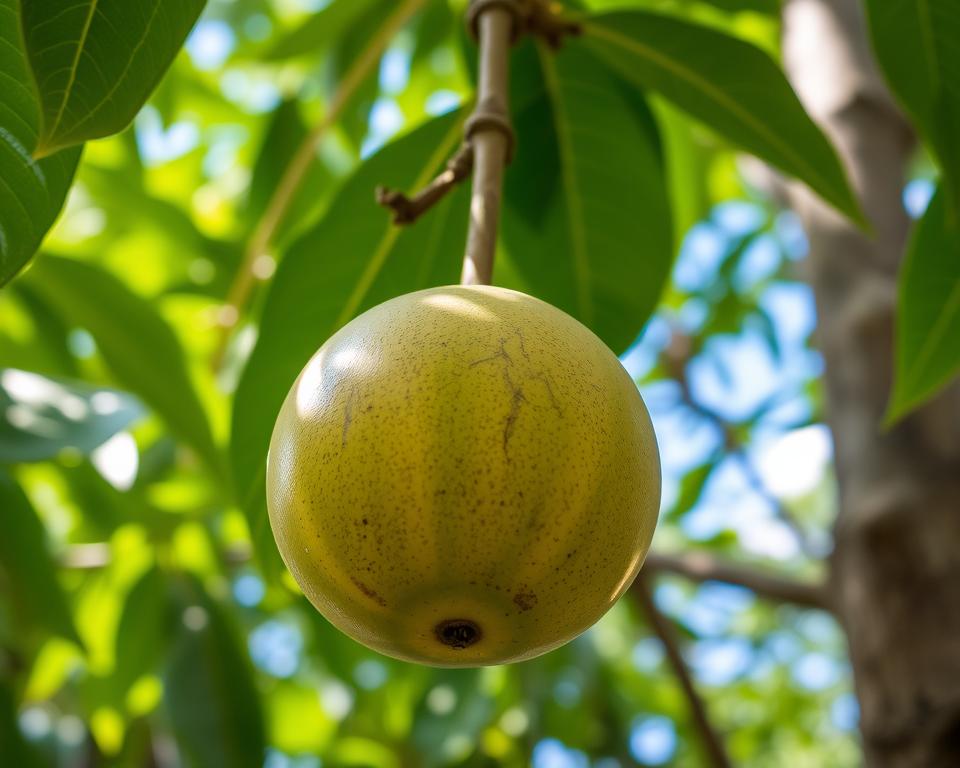Lotus root is a special aquatic vegetable that has been a key ingredient in Asian cooking for a long time. It’s loved for its crunchy texture, rich flavor, and high nutritional value. This rhizome grows in the calm waters of lotus ponds and has a deep history and cultural importance.
It’s not just for cooking. Lotus root has been used in traditional medicine for years. Now, it’s becoming more popular in fancy dishes too. This makes it a key part of Asian food traditions.
Read interesting things at : tosawakan
Key Takeaways
- Lotus root is a unique and nutritious aquatic vegetable with a long history in Asian cuisines.
- It is prized for its crunchy texture, earthy flavor, and impressive nutritional benefits.
- Lotus root has a wide range of culinary applications, from traditional dishes to modern gourmet creations.
- Beyond its culinary uses, lotus root is also valued as a traditional ingredient in herbal medicine.
- Sustainable cultivation and incorporation of lotus root into one’s diet can offer both health and environmental benefits.
What is Lotus Root?
Lotus root, known as Nelumbo nucifera, is the edible part of the lotus plant. It grows in ponds, lakes, and other water places. It looks unique, with a long, cylindrical shape and holes along its length.
Introduction to the Unique Aquatic Rhizome
This special look has made the lotus root a symbol of purity and divinity in many Asian cultures. It’s a water plant used in Asian cooking and is known for its health benefits.
History and Cultural Significance
The lotus root, or esculenta, has a long history in Asian cultures. It’s valued for its cultural significance and used in traditional ways, like in religious ceremonies and medicine. The lotus root stands for purity, fertility, and enlightenment. Its unique look is often seen in art, literature, and myths.
“The lotus is the most beautiful flower, whose petals open one by one. But it will only grow in the mud. In order to grow and blossom, you need the mud.” – Thich Nhat Hanh
Nutritional Benefits of Lotus Root
Lotus root is a nutrient-rich aquatic vegetable. It’s full of vitamins, minerals, and compounds that are good for you. It’s a great source of vitamin C, which helps keep your immune system strong and supports collagen production. It also has vitamin B6, which is important for breaking down proteins, fats, and carbs.
Lotus root is also packed with potassium, iron, and manganese. Potassium helps keep your blood pressure healthy. Iron is key for making red blood cells and preventing anemia. Manganese supports bone health and helps enzymes work right.
Lotus root is high in dietary fiber. This fiber is good for your digestive health, helps with regular bowel movements, and can make you feel full. It’s a great choice for a healthy diet.
| Nutrient | Amount per 100g of Lotus Root |
|---|---|
| Vitamin C | 38% of the Daily Value |
| Vitamin B6 | 12% of the Daily Value |
| Potassium | 9% of the Daily Value |
| Iron | 7% of the Daily Value |
| Manganese | 15% of the Daily Value |
| Dietary Fiber | 2.5g |
Adding lotus root to your diet is a smart move to get more vitamins, minerals, and fiber. You can enjoy it as a snack, in stir-fries, or in soups and stews. It’s a versatile and nutritious choice for any meal.
Versatility in Asian Cuisine
Lotus root is a key ingredient in Asian cooking. It’s crunchy and slightly sweet. It’s used in many dishes, from stir-fries to snacks, in China, Japan, and India.
Its unique texture and mild taste make it fit well in many Asian dishes. You can cook it boiled, steamed, fried, or pickled. This makes it a favorite in many kitchens.
In China, it’s stir-fried with veggies, added to soups, or used in salads. Japan uses it in tempura, dashi broth, or pickled for a special flavor.
In the Indian subcontinent, it’s called kamal kakdi. It goes into curries, chutneys, and even traditional medicines. Its ability to soak up flavors and keep a firm texture is very useful in Indian cooking.
| Cuisine | Preparation Methods | Signature Dishes |
|---|---|---|
| Chinese | Stir-fry, Soup, Salad | Lotus Root Salad, Lotus Root with Pork, Lotus Root Soup |
| Japanese | Tempura, Simmered, Pickled | Lotus Root Tempura, Kinpira Gobo (Simmered Lotus Root), Tsukemono (Pickled Lotus Root) |
| Indian | Curry, Chutney, Ayurvedic Medicine | Kamal Kakdi Curry, Kamal Kakdi Chutney, Kamal Kakdi in Ayurvedic Remedies |
Lotus root is very versatile in Asian cooking. It fits well in many dishes, adding a unique texture and flavor. This makes it a key ingredient in many Asian recipes.
Lotus Root as a Crunchy Vegetable
Lotus root is known for its crunchy texture, similar to water chestnut or jicama. This makes lotus root a favorite for adding crunch to dishes. It’s crucial to clean and peel the root before cooking.
Preparing and Cooking Methods
Lotus root can be eaten raw, sliced thin for salads. Or, it can be cooked by stir-frying, steaming, or deep-frying. These methods bring out the crunchy vegetable texture.
- Stir-frying: Slice the lotus root thinly and stir-fry with seasonings and other veggies for a tasty dish.
- Steaming: Steam peeled and sliced lotus root until it’s tender but still crunchy.
- Deep-frying: Deep-fry lotus root until golden brown for a crispy snack that highlights its crunchy quality.
Using different cooking methods, lotus root adds a unique texture to many Asian-inspired dishes. It’s great in stir-fries, salads, and more.
“Lotus root is a versatile and underappreciated vegetable that adds a wonderful crunch to any dish.”
Traditional Ingredient in Herbal Medicine
Lotus root is more than just a food item. It has a long history in traditional herbal medicine, especially in Asian cultures. People have used it for centuries to treat various health issues.
In traditional Chinese medicine, lotus root helps with digestion problems like diarrhea and dysentery. It’s also seen as a way to reduce inflammation. This makes it good for treating arthritis and breathing issues.
“Lotus root has been used in traditional Chinese medicine for centuries to promote overall health and well-being.”
Lotus root is not just used alone in medicine. It’s often mixed with other herbs and spices in formulas and tonics. This mix boosts its healing powers.
Even though we need more studies to prove its health benefits, lotus root has a strong place in traditional medicine. Its use shows the deep cultural value of this unique plant.
As lotus root becomes more popular, its traditional uses show the lasting value of ancient healing ways. They also highlight the amazing uses of this special plant.
Lotus Root Cultivation
Lotus root is a unique aquatic vegetable grown mainly in Asia. It thrives in warm, humid places with lots of water, like ponds or flooded rice fields. Growing this rhizome needs a lot of care to get the best results.
Growing Requirements and Challenges
Lotus root growing has its ups and downs. The plants need regular care, like keeping the water right and controlling pests. It’s important to keep the water deep enough, between 30 and 60 centimeters, for the roots to grow well.
Too little or too much water can stop the roots from growing. This can mean a smaller harvest.
- Dealing with pests is a big part of growing lotus roots. Beetles and snails like the water and can harm the plants. Growers must watch out and use pest control to protect their lotus roots.
- The soil type is also key for growing lotus roots. They do best in rich, slightly acidic soil with good drainage. Finding the right soil balance can be hard, especially in places with poor soil.
Even with challenges, growing lotus roots is still big in Asia. There’s a lot of demand for this vegetable. Skilled growers who can handle the unique needs and challenges can enjoy a big harvest.
Incorporating Lotus Root into Your Diet
Lotus root is a unique and nutritious aquatic vegetable. It has a crunchy texture and a subtle, sweet flavor. Adding lotus root to your meals can make them more diverse, nutritious, and exciting.
One easy way to enjoy lotus root is in stir-fries. Slice it into thin pieces and sauté with your favorite veggies, proteins, and seasonings. The lotus root adds a satisfying crunch that goes well with other flavors.
Lotus root is great in soups and stews too. Add it to your broth-based dishes for a unique texture. It’s especially good in Asian-inspired soups like miso or hot and sour soup.
For a refreshing salad, use lotus root slices or shredded lotus root. Its mild flavor makes it a versatile addition to green or grain-based salads. It adds a delightful contrast to other ingredients.
Snacking on lotus root is also a great idea. Slice it thin, toss with oil and seasonings, and bake or air-fry until crispy. These lotus root chips are a wholesome alternative to traditional potato chips.
“Incorporating lotus root into your diet is a fantastic way to add variety, nutrition, and crunch to your meals.”
Looking to try new Asian-inspired dishes or add more nutrients to your diet? Lotus root is a versatile and tasty choice. It brings a unique flavor and texture to your meals, making them more exciting.
Exploring Unique Lotus Root Dishes
Lotus root is a favorite in many Asian dishes. It has inspired a wide range of unique dishes across different cultures. Each culture has its own special way of preparing and seasoning this aquatic vegetable.
Lotus Root in Chinese Cuisine
In China, lotus root is often used in stir-fries, soups, and as a crispy snack. A favorite dish is Luk Ku, where it’s stir-fried with garlic, chili peppers, and soy sauce. This makes for a savory and crunchy treat. In Sichuan, it’s part of Mapo Tofu, a spicy tofu dish that adds a unique texture and flavor.
Lotus Root in Japanese Cuisine
Japan also values the lotus root in its cuisine. Tempura Renkon, or lotus root tempura, is a well-known appetizer. It’s made by battering and deep-frying thin slices of lotus root until crispy. In salads, it adds a crunchy texture and pairs well with tangy dressings. Simmered dishes like Renkon no Nimono highlight the root’s ability to soak up flavors.
Lotus Root in Indian Cuisine
In the Indian subcontinent, lotus root is known as Kamal Kakdi. It has a long history in traditional cooking. In curries, it brings a unique earthy and slightly sweet flavor, as seen in Kamal Kakdi Curry. It’s also used in fritters, like Kamal Kakdi Pakora, which are coated in a spiced chickpea batter and fried until golden.
Exploring these regional dishes shows how much lotus root is cherished in Asian cuisine. It highlights the diverse ways it’s used in traditional cooking.
Lotus Root in Modern Cuisine
Lotus root has been a key ingredient in Asian cooking for a long time. Now, it’s making its mark in modern and innovative dishes. Chefs and food lovers worldwide are getting creative with lotus root, adding it to many modern cuisine and contemporary dishes.
Lotus root is being used in everything from fries and chips to purees and desserts. Its crunch, mild taste, and health benefits make it perfect for many modern cuisine and contemporary dishes.
Top chefs are using lotus root in dishes that mix Eastern and Western flavors. For example, a lotus root and sweet potato gratin combines the earthy taste of lotus root with the sweetness of potato in a creamy casserole.
“Lotus root is an underutilized ingredient with so much potential. It’s a pleasure to experiment with its unique texture and subtle flavor in my dishes.”
– Chef Lina Wang, Michelin-starred restaurant
Not just for savory dishes, lotus root is also in desserts. Using lotus root puree can add sweetness and a creamy feel to desserts like tarts or ice cream.

The culinary world is discovering the endless possibilities of lotus root. It’s set to become a key ingredient in modern cuisine and contemporary dishes globally.
Selecting and Storing Lotus Root
When picking the perfect lotus root, look for ones that are firm and have a bright, clean look. Stay away from roots that seem soft, have color issues, or show damage. The key to enjoying its unique taste and texture is its freshness and crunch.
After finding the right lotus root, it’s important to store it well. Keep it in the fridge, wrapped in a damp paper towel or in a sealed plastic bag. This keeps it fresh for about a week. If you want to keep it longer, you can freeze it, which also extends its shelf life.
| Criteria | Ideal Lotus Root | Rejected Lotus Root |
|---|---|---|
| Appearance | Firm, unblemished, bright, and clean | Soft, discolored, or showing signs of damage |
| Texture | Crunchy and fresh | Mushy or wilted |
| Shelf Life | Up to 1 week in the refrigerator, or longer when frozen | Shorter shelf life due to deterioration |
By choosing and storing your lotus root with care, you can enjoy its unique taste and versatility. Whether you’re making a traditional Asian dish or trying something new, picking the right lotus root is key to a great meal.
Environmental Impact of Lotus Root Farming
The growth of lotus root can affect the environment in good and bad ways. Lotus plants clean water by taking in pollutants and extra nutrients. This makes them a good choice for farming in water.
But, growing lotus root on a big scale can harm the environment. It can use up water, damage soil, and lead to the use of harmful chemicals. It’s important to use sustainable farming practices to lessen the harm and keep lotus root farming going for a long time.
Sustainable Practices and Considerations
To lessen the harm of lotus root farming, farmers can follow these sustainable practices:
- Organic farming, which means not using synthetic fertilizers and pesticides
- Water-saving methods, like drip irrigation or recycling water
- Using natural ways to control pests instead of chemicals
- Rotating crops and using cover crops to keep soil healthy
- Reducing waste and using compost or recycling plant materials
By using these sustainable practices, lotus root farmers help make this food sustainable for the future.
| Sustainable Practice | Benefit |
|---|---|
| Organic Cultivation | Avoids synthetic chemicals, promotes soil health |
| Water Conservation | Reduces water usage, preserves water resources |
| Integrated Pest Management | Minimizes chemical pesticide use, relies on natural methods |
| Crop Rotation and Cover Cropping | Maintains soil fertility, prevents erosion |
| Waste Reduction and Composting | Minimizes environmental impact, recycles plant materials |
By using these sustainable practices, lotus root farmers can lessen their environmental impact. This helps keep this aquatic vegetable available for the future.
“Sustainable lotus root farming is not just about protecting the environment, but also ensuring the long-term availability of this nutritious and versatile aquatic vegetable for generations to come.”
Lotus Root Recipes for Beginners
For beginners, lotus root offers many easy recipes. These recipes are a great way to start your culinary adventure with this unique ingredient. You’ll find many delicious ways to prepare and enjoy this crunchy vegetable.
A simple yet tasty recipe is stir-fried lotus root with garlic and soy sauce. It brings out the lotus root’s crunch and pairs it with savory flavors. Just slice the lotus root thinly, sauté it with garlic, and add soy sauce and scallions at the end.
Another easy recipe is a lotus root and vegetable salad. Combine lotus root slices with carrots, cucumbers, and radishes. Then, dress it with a light vinaigrette for a fresh and healthy side dish.
As you get more comfortable with lotus root, try more complex dishes like lotus root fritters, lotus root soup, or lotus root-based desserts. There are endless ways to use this versatile ingredient in your cooking.

If you’re new to lotus root or want to try new recipes, these are perfect for you. Start with these beginner-friendly recipes to enjoy the unique taste and texture of this aquatic vegetable. Let your creativity flow as you discover the many ways to enjoy lotus root.
The Elusive Water Lentils (Lotus Root Seeds)
The lotus root is well-known, but its seed, or “water lentils,” is a hidden gem. These small seeds are inside the lotus flower’s pods. They’ve been used in Asian cooking and medicine for a long time.
Lotus seeds are becoming popular for their unique taste and health benefits. They are soft and taste a bit sweet and nutty. You can eat them raw, roasted, or add them to many dishes, from stir-fries to desserts.
Nutritional Profile of Lotus Seeds
Lotus seeds are packed with nutrients. They’re full of fiber, which helps with digestion and feeling full. They also have a lot of protein, vitamins, and minerals like:
- Vitamin B6, which supports red blood cell function and immune health
- Magnesium, an essential mineral for bone, muscle, and nerve function
- Copper, which helps the body produce red blood cells and maintain healthy nerves
Adding lotus seeds to your meals can be tasty and good for your health.
Culinary and Medicinal Uses of Lotus Seeds
In Asian cooking, lotus seeds are often in sweet dishes like congee or desserts. They’re also in savory dishes, like stir-fries, soups, and stews. In traditional Chinese medicine, they help with fatigue, insomnia, and digestive problems.
Even though lotus seeds have a long history and many benefits, they’re not well-known in many places. As more people learn about them, they might start using them more in cooking and medicine.
If you’re looking to try new foods or add something nutritious to your diet, the lotus seed is worth exploring.
Lotus Root: Nutritious and Versatile Aquatic Vegetable
Lotus root is a gem in the culinary world, known for its rich history and cultural importance. It has a crunchy texture and an earthy flavor. Plus, it’s packed with nutrients, making it great for a balanced diet.
This aquatic vegetable is full of vitamins and minerals. It’s high in fiber and vitamins C and B6. These nutrients support many aspects of health.
Lotus root is also very versatile in cooking. It’s a staple in Asian cuisine and can be made into many dishes. You can stir-fry it, make soups, pickles, or even baked goods. Its texture and flavor work well with many other ingredients, letting cooks get creative.
If you’re looking to try new dishes or add more nutrients to your meals, lotus root is a great pick. It brings both culinary and health benefits to your table. Discover how this aquatic vegetable can enhance your cooking.
“Lotus root is a true marvel of nature, offering both incredible taste and remarkable nutritional value. Its versatility in the kitchen is truly unparalleled.”
The lotus root has a long history and many modern uses. It shows the beauty of nature. Start exploring this aquatic vegetable and enjoy adding it to your meals.
Conclusion
The lotus root is a fascinating and versatile aquatic vegetable. It has a rich cultural background and is packed with nutrients. It adds a unique and tasty touch to many dishes.
As more people try it, the lotus root is set to enchant food lovers and inspire new recipes. Its journey from ancient Asian traditions to modern kitchens shows its lasting charm. It has a crunchy texture, a versatile taste, and is full of nutrients.
This makes it a great addition to any meal. Chefs and home cooks can use it to make dishes that are both tasty and beautiful.
The lotus root is perfect for those looking for diverse and healthy ingredients. It offers a special culinary experience that highlights nature’s beauty and human creativity. With its deep history, nutritional value, and endless possibilities, the lotus root is becoming a favorite worldwide.










